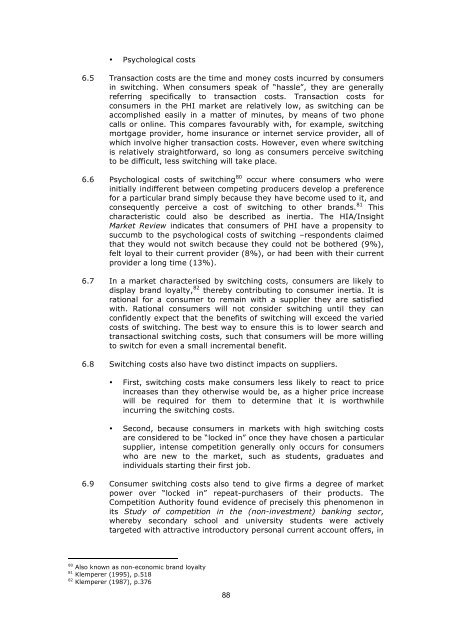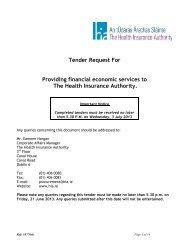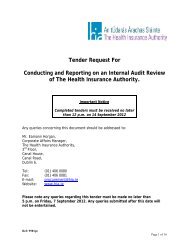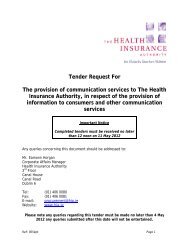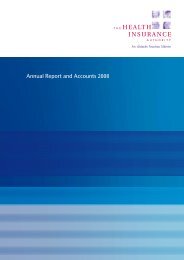Competition in the Irish Private Health Insurance Market
Competition in the Irish Private Health Insurance Market
Competition in the Irish Private Health Insurance Market
Create successful ePaper yourself
Turn your PDF publications into a flip-book with our unique Google optimized e-Paper software.
• Psychological costs<br />
6.5 Transaction costs are <strong>the</strong> time and money costs <strong>in</strong>curred by consumers<br />
<strong>in</strong> switch<strong>in</strong>g. When consumers speak of “hassle”, <strong>the</strong>y are generally<br />
referr<strong>in</strong>g specifically to transaction costs. Transaction costs for<br />
consumers <strong>in</strong> <strong>the</strong> PHI market are relatively low, as switch<strong>in</strong>g can be<br />
accomplished easily <strong>in</strong> a matter of m<strong>in</strong>utes, by means of two phone<br />
calls or onl<strong>in</strong>e. This compares favourably with, for example, switch<strong>in</strong>g<br />
mortgage provider, home <strong>in</strong>surance or <strong>in</strong>ternet service provider, all of<br />
which <strong>in</strong>volve higher transaction costs. However, even where switch<strong>in</strong>g<br />
is relatively straightforward, so long as consumers perceive switch<strong>in</strong>g<br />
to be difficult, less switch<strong>in</strong>g will take place.<br />
6.6 Psychological costs of switch<strong>in</strong>g 80 occur where consumers who were<br />
<strong>in</strong>itially <strong>in</strong>different between compet<strong>in</strong>g producers develop a preference<br />
for a particular brand simply because <strong>the</strong>y have become used to it, and<br />
consequently perceive a cost of switch<strong>in</strong>g to o<strong>the</strong>r brands. 81 This<br />
characteristic could also be described as <strong>in</strong>ertia. The HIA/Insight<br />
<strong>Market</strong> Review <strong>in</strong>dicates that consumers of PHI have a propensity to<br />
succumb to <strong>the</strong> psychological costs of switch<strong>in</strong>g –respondents claimed<br />
that <strong>the</strong>y would not switch because <strong>the</strong>y could not be bo<strong>the</strong>red (9%),<br />
felt loyal to <strong>the</strong>ir current provider (8%), or had been with <strong>the</strong>ir current<br />
provider a long time (13%).<br />
6.7 In a market characterised by switch<strong>in</strong>g costs, consumers are likely to<br />
display brand loyalty, 82 <strong>the</strong>reby contribut<strong>in</strong>g to consumer <strong>in</strong>ertia. It is<br />
rational for a consumer to rema<strong>in</strong> with a supplier <strong>the</strong>y are satisfied<br />
with. Rational consumers will not consider switch<strong>in</strong>g until <strong>the</strong>y can<br />
confidently expect that <strong>the</strong> benefits of switch<strong>in</strong>g will exceed <strong>the</strong> varied<br />
costs of switch<strong>in</strong>g. The best way to ensure this is to lower search and<br />
transactional switch<strong>in</strong>g costs, such that consumers will be more will<strong>in</strong>g<br />
to switch for even a small <strong>in</strong>cremental benefit.<br />
6.8 Switch<strong>in</strong>g costs also have two dist<strong>in</strong>ct impacts on suppliers.<br />
• First, switch<strong>in</strong>g costs make consumers less likely to react to price<br />
<strong>in</strong>creases than <strong>the</strong>y o<strong>the</strong>rwise would be, as a higher price <strong>in</strong>crease<br />
will be required for <strong>the</strong>m to determ<strong>in</strong>e that it is worthwhile<br />
<strong>in</strong>curr<strong>in</strong>g <strong>the</strong> switch<strong>in</strong>g costs.<br />
• Second, because consumers <strong>in</strong> markets with high switch<strong>in</strong>g costs<br />
are considered to be “locked <strong>in</strong>” once <strong>the</strong>y have chosen a particular<br />
supplier, <strong>in</strong>tense competition generally only occurs for consumers<br />
who are new to <strong>the</strong> market, such as students, graduates and<br />
<strong>in</strong>dividuals start<strong>in</strong>g <strong>the</strong>ir first job.<br />
6.9 Consumer switch<strong>in</strong>g costs also tend to give firms a degree of market<br />
power over “locked <strong>in</strong>” repeat-purchasers of <strong>the</strong>ir products. The<br />
<strong>Competition</strong> Authority found evidence of precisely this phenomenon <strong>in</strong><br />
its Study of competition <strong>in</strong> <strong>the</strong> (non-<strong>in</strong>vestment) bank<strong>in</strong>g sector,<br />
whereby secondary school and university students were actively<br />
targeted with attractive <strong>in</strong>troductory personal current account offers, <strong>in</strong><br />
80 Also known as non-economic brand loyalty<br />
81 Klemperer (1995), p.518<br />
82 Klemperer (1987), p.376<br />
88


